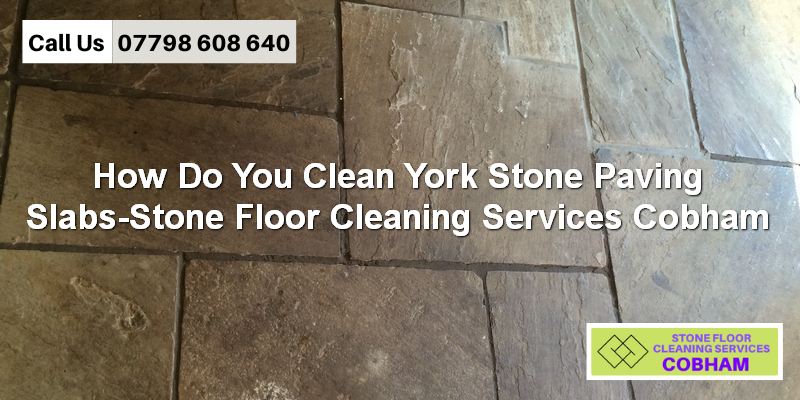How Do You Clean York Stone Paving Slabs?

York stone is a type of sandstone found in Yorkshire, England. Builders have used the stone for centuries for paving, flooring, and other decorative applications. York stone has a recognisable buff colour and a fine-grained texture. A wide range of flagstones is called York stone, e.g., sandstone, quartzite, limestone and even slate. But there are differences in colour, porosity, condition, and hardness.
Cleaning York Stone Flags Or Pavers Brings Various Challenges
Yorkstone is a popular paver for outdoor and indoor floors, presenting different cleaning challenges. The condition of York stone flags or pavers affects impact the cleaning results.
Cement screed, old urethane or bitumen coatings must be removed mechanically or with specialised chemicals before cleaning.
Flags can suffer surface delamination and require aggressive milling or sandblasting to renovate the surface.
In addition to traffic wear, outdoor pavers suffer weathering and organic staining.
How to deep clean an interior Yorkshire sandstone-flagged floor
Technicians use alkaline waterborne cleaners clean interior sandstone floors. The chemical is allowed to work on the soils for 10 minutes and then agitated into the stone's pores with a slow-speed rotary scrubbing machine.
Combining chemicals and scrubbing releases soils from the stone to be removed by a wet vacuum.
A wet vacuum removes the dirty slurry, rinsing the floor with clean water.
If the stone finish has degraded, is exceptionally rough or delaminated, milling with diamond pads can reduce the roughness and improve the appearance.
Cleaning reveals the stone's original colour and any previously hidden stains.
Cleaning exterior York stone flags, pavers, walls, or lintels
In addition to soils, exterior pavers get colonised by lichens, moss and other organic contaminants. Lichens are especially difficult to remove. Lichens are two living organisms, algae or bacteria, living in symbiosis with a fungus. The fungus grows deep into the stone to capture minerals, making it very difficult to remove the Lichen mechanically.
Historically, Lichen was either left in place or removed by a combination of acid treatments and pressure washing.
Unfortunately, this cleaning approach permanently damages the stone.
Now we have organic treatments to break down the Lichen without damaging the stone. There are also ongoing treatments to prevent recolonisation.
How to remove paint from York stone floors
Old floors often have old paint splashes. Vigorous machine scrubbing with strong alkaline cleaners may remove the spills. When scrubbing fails, industrial paint removers are needed.
Removing oil stains from York stone
Over time oil spills oxidise and bond to the sand particles, making them difficult to remove. Sometimes technicians can lighten the stains by cleaning or using a poultice. But, often, the only way to remove them is by grinding away the surface. Grinding is a drastic and costly process, so it is usually better to accept the marks as part of the history of the stone.
Removing cement or grout from interior or exterior York stone
Technicians use a grinder or hammer and chisel to remove thick cement deposits from York stone and flagstones. Acid grout cleaners remove any cement staining. Technicians will test first to ensure there are no calcium or ferrous minerals in the rock that can be attacked by the acid and discolour the stone. Also, some flagstones are not sandstone, but limestone, e.g. Costwold stone and acids will permanently damage them. So much experience, skill and equipment are needed when treating cement deposits.
Removing Efflorescence from York Stone
Efflorescence can be a problem in damp environments on indoor and outdoor flooring. Efflorescence is a salt deposited on the surface after moisture has evaporated. Acid efflorescence treatments remove light deposits. Heavy lumps need to be ground or chipped away.
If the floor or subfloor is continually damp, the efflorescence will reappear until the moisture issue is solved.
How to remove rust marks from York stone floors
Considering the possible issues above about using acid on sandstone, technicians use non-acidic rust removers to help remove surface rust marks from york stone. If the stone has iron minerals in the rock, rust marks may be a permanent feature.
Stripping old sealers before sealing
Old coatings can be problematic on York stone. Old solvent-borne acrylics and urethanes need powerful removing agents and should only be used by trained specialists. Sandblasting is another option, but the cost will likely determine the method.
Grouting Yorkshire sandstone flags
York stone will be grouted or pointed with lime mortar, a sand cement mix or a modern grout. Artisans used Lime mortar on older floors, which was ideal because the mortar is breathable and best suited to floors without a damp-proof membrane. Modern brush-in compounds are used for outdoor flags to help water drain. They are not suitable for interior floors.
Sealing Yorkstone Pavers
Sealing York stone improves the appearance of the stone, makes the floor easier to clean and helps stop spills from turning into permanent stains. On outdoor stone, sealing inhibits the growth of Lichens and other organic substances.
Sandstone is generally sealed with an impregnating sealer, allowing the stone to breathe. However, a topical sealer can seal internal floors with a damp-proof membrane.
In conclusion
Yourkstone has its issues regarding cleaning and sealing. An experienced professional has the tools and materials to solve these problems.
Frequently Asked Questions
What is the best way to clean Yorkstone?
For indoor stone use a Ph neutral stone cleaner. For outdoor stone you may need to use specialist cleaners to remove lichen and other organic materials. After using patio cleaner ensure that the stone is thoroughly rinsed with water.
Does York stone need to be sealed?
Newly laid 'modern' York stone should be sealed with an impregnating sealer that allows the stone to breathe. Modern resin based sealers give a longer life and will highlight the colour variations in India Sandstone.
Does York stone stain?
Sandstone and York Stone paving provides a durable, hard wearing surface, but like any other surfacing material, may suffer from staining.